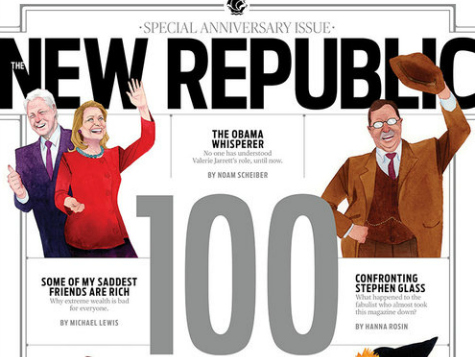Reports of the New Republic‘s death have been greatly understated–and more than a half-century late.
The decision of boy-millionaire Chris Hughes to jettison editors, relocate from Washington to New York, and recast the biggest of the Little Magazines as, in the words of flunky Guy Vidra, “a vertically integrated digital media company” convinced more than fifty employees to resign en masse last week.
Headlines from sympathetic outlets struck a funereal tone. New York magazine offered a “eulogy.” Esquire called the transformation a “lingering death.” Slate pondered “what we lost with the loss of the New Republic.”
The gauche, arrogant young owner aspiring to morph a bastion of longform into Buzzfeed provoking such a visceral response on one level bespeaks health in modern liberalism. On another, when juxtaposed with the precedent of a similarly narcissistic publisher transforming the New Republic into the Western Hemisphere’s version of Pravda, the uproar indicates its sickness. Liberals can stomach a traitor at the helm; a dolt, never.
Before a Facebook millionaire destroyed the New Republic, Joe Stalin’s millionaire did.
Michael Straight, who appeared on the New Republic masthead as an editor or publisher from 1941 to 1963, became an agent of the Soviet Union while studying at Cambridge in the 1930s. At the direction of his Soviet handlers, he gained positions in the Departments of State and Interior, and as a speechwriter for President Franklin Roosevelt. Before ditching a life of espionage in 1942 as a result of disillusionment with the USSR over the Hitler-Stalin Pact, induction into the Army, and the death of a handler, Straight embarked on a literary career at the magazine his parents played founding funders to.
At the New Republic, Straight pursued a self-dealing editorial line that ridiculed the idea that Communists had infiltrated the U.S. government. His experience obtaining employment in the U.S. government while serving as an agent of the Soviet Union seemed to gainsay this stance. Although Straight had identified Alger Hiss and Laurence Duggan as ripe for recruitment to his Soviet handlers, who had, unbeknownst to Straight, already recruited them, his magazine contended that such men had been the victims of a witch hunt when anti-Communists saw them in the 1940s as Straight had in the 1930s. Upon Duggan’s 1948 suicide, for instance, Straight’s journal accused critics of the disgraced State Department official of having “blackened the dead patriot’s name.” It was not without reason that British spy Anthony Blunt told Moscow in 1946 that his friend Straight “in principle remains our man.”
Straight belatedly confessed his transgressions to the government during the Kennedy administration, which helped bring down the Cambridge spy ring in Great Britain. It didn’t bring down Straight or the magazine on whose masthead he had appeared since 1941. The Kennedy administration kept his secret. He later reasoned in his 1983 autobiography After Long Silence that a confession immediately following his break from Stalin during the Second World War “seemed to threaten the well-being of a national journal.” The New Republic strangely inspired more loyalty from its publisher than the Old Republic.
Rather than a bizarre anomaly, a Soviet spy presiding over the New Republic after World War II represented a continuity with the magazine’s indefensible support of Soviet tyranny after World War I. The New Republic persuaded readers in the wake of the Bolshevik coup that overthrew the people who overthrew the czarist system that reports of a centralized dictatorship meting out summary executions didn’t match reality. The publication reported that “the Soviet government has abolished capital punishment,” “Soviet power is an extreme instance of decentralization,” and the fledgling state represented “the most democratic franchise yet devised in our world.”
The current demonstrative mourning over the death of the New Republic stems as much from a confusion that old necessarily means venerable as it does from institutional amnesia. This latter condition currently afflicting the magazine’s grieving writers mirrors the longstanding behavior of its subscribers. A magazine more referenced than read, the New Republic, like a living-room library packed with dusted-over old tomes containing uncut pages, represented a sort of intellectual “conspicuous consumption.” For $59.95 a year, subscribers bought automatic urbanity, respectability, and enlightenment. Even when it jacketed a Mad magazine beneath, the New Republic was smart reading.
More than a dozen past editors–including Sidney Blumenthal, Robert Reich, Sean Wilentz, and Andrew Sullivan, who served a New Republic long removed from its Communist past–penned an open letter on the magazine’s “destruction in all but name” last week. In a ’50s-era crisis over funding, Michael Straight and the journal’s old hands worried of the New Republic suffering a similar fate if sold.
“They are a storehouse of all that was fine in American thought in our lifetimes,” publisher Dan Mebane told predecessor Michael Straight as he pointed to the bound collection of the journal’s issues. “It would be better to close down the New Republic in a dignified manner than to see it dishonor its own tradition.”
The current hand-wringing over an uncouth ignoramus’s hijacking of a century-old magazine misses the difficulty in further dishonoring a publication boasting such a dishonorable tradition. Alas, a magazine dedicated to the noble lie for the first half of its existence, and to intellectual pretentiousness for much of the remainder, bequeaths a culture of deception, even if only, in this case, self-deception.
Daniel J. Flynn, the author of A Conservative History of the American Left (Crown Forum, 2008), edits Breitbart Sports.

COMMENTS
Please let us know if you're having issues with commenting.